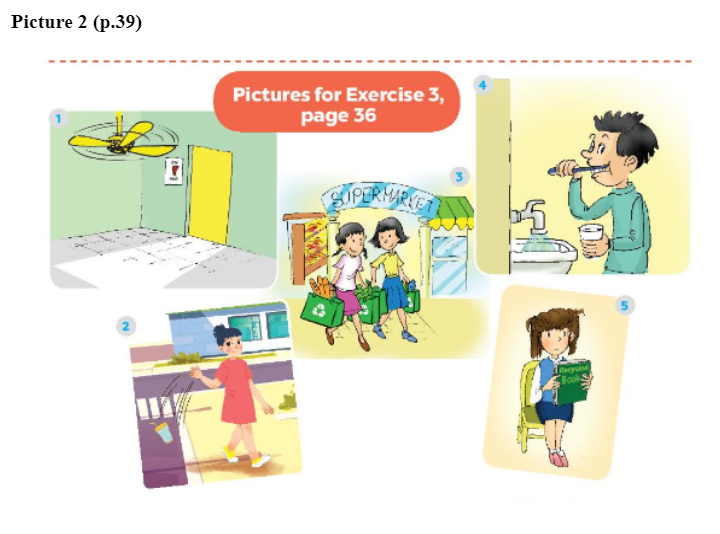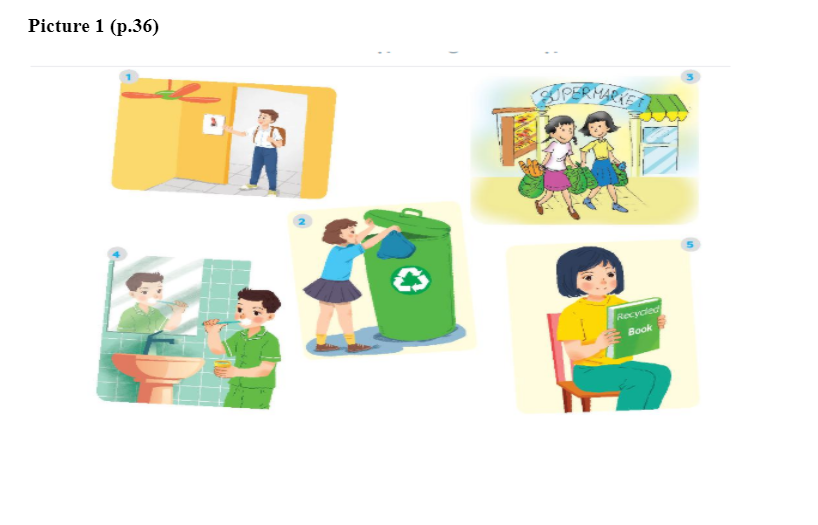1. Use the given words and phrases below to make a conversation between two friends. Make necessary changes and add some words
(Sử dụng các từ để viết câu để tạo thành cuộc hội thoại. Thay đổi và thêm một số từ nếu cần thiết)
Mai: You / water / flowers, Phong?
Phong: Yes / am.
Mai: Don’t water / flower / noon.
Phong: Why?
Mai: If / you / water / plants / noon, they / will / die.
Phong: Thank / you. I / not know / that.
Mai: Are you watering flowers, Phong?
(Bạn đang tưới hoa à Phong?)
Phong: Yes, I am.
(Đúng thế.)
Mai: Don’t water flowers at noon.
(Đừng tưới hoa vào buổi trưa.)
Phong: Why?
(Tại sao?)
Mai: If you water plants at noon, they will die.
(Nếu bạn tưới hoa vào buổi trưa, chúng sẽ chết)
Phong: Thank you. I don’t know about that.
(Cảm ơn bạn. Mình không biết về điều đó.)

Các bài tập cùng chuyên đề
5. Find someone who ...
Work in groups. Ask and answer to find someone who does the things in 4.
(Hãy tìm người nào mà ... làm việc nhóm. Hỏi và trả lời để tìm một người làm những việc trong câu 4.)
A: Do you plant trees?
(Bạn có trồng cây không?)
B: No, I don't.
(Không, tôi không.)
A: Do you pick up rubbish?
(Bạn có nhặt rác không?)
B: Yes, I do.
(Vâng, tôi có.)
2. Work in pairs. Student A is watering flowers in the garden. Student B is giving some warnings. Act out the dialogue. Remember to use the highlighted language in 1.
(Làm việc theo cặp. Học sinh A đang tưới hoa trong vườn. Sinh viên B đang đưa ra một số cảnh báo. Diễn lại đoạn hội thoại này. Hãy nhớ sử dụng ngôn ngữ được làm nổi bật trong câu 1.)
4. Interview a classmate, using the questions in 3. Compare your answers. How many different answers have you got?
(Phỏng vấn một bạn cùng lớp, sử dụng các câu hỏi trong 3. So sánh các câu trả lời của bạn. Bạn có bao nhiêu câu trả lời khác nhau?)
Example:
A: What's your answer to Question 1?
(Câu trả lời của bạn cho câu hỏi 1 là gì?)
B: It's A. What's your answer?
(Là A. Câu trả lời của bạn là gì?)
4. Nam mentions the following tips in the interview. Work in groups and discuss to put the tips in order from the easiest to the most difficult.
(Nam đề cập đến những lời khuyên sau đây trong cuộc phỏng vấn. Làm việc theo nhóm và thảo luận để đưa ra các mẹo theo thứ tự từ dễ nhất đến khó nhất.)
a. Putting recycling bins in every classroom.
(Đặt thùng rác tái chế trong mỗi lớp học.)
b. Exchanging old books and uniforms with fnends or giving them to charity.
(Trao đổi sách và đồng phục cũ với các mối quan hệ hoặc tặng chúng cho tổ chức từ thiện.)
c. Borrowing books from the school library instead of buying new ones.
(Mượn sách từ thư viện trường thay vì mua sách mới.)
d. Bringing reusable water bottles to school.
(Mang chai nước có thể tái sử dụng đến trường.)
e. Planting trees at school.
(Trồng cây ở trường.)
f. Finding creative ways to reuse old items befor throwing them away.
(Tìm cách sáng tạo để tái sử dụng những món đồ cũ có thể là vứt chúng đi.)
5. Tip f tells you to find creative ways to reuse old items. Can you think of any ways to reuse.
(Mẹo f cho bạn biết cách sáng tạo để tái sử dụng những món đồ cũ. Bạn có thể nghĩ ra bất kỳ cách nào để sử dụng lại.)
a. used gift wrap?
(giấy gói quà đã được sử dụng?)
b. used water bottles?
(chai nước đã được sử dụng?)
c. used books?
(sách đã được sử dụng?)
IDEAS ABOUT REUSING OLD THINGS
1. What can you see in each picture?
(Bạn có thể nhìn thấy gì trong mỗi bức tranh?)
What did people use to make the things in the pictures?
(Người ta đã sử dụng gì để làm ra những thứ trong tranh?)
2. Now work in pairs or in groups to complete the project.
(Bây giờ làm việc theo cặp hoặc theo nhóm để hoàn thành dự án.)
- Choose a used object (a bottle, a sheet of paper, etc.).
(Chọn một đồ vật đã sử dụng (một cái chai, một tờ giấy, v.v.).)
- Make something new from it and decorate it.
(Làm một cái gì đó mới từ nó và trang trí nó.)
- Bring it to class.
(Mang đến lớp.)
- Do a "show and tell" about it.
(Làm một "chương trình và kể" về nó.)
3. Listen to other presentations and decide which is the best.
(Nghe các bài thuyết trình khác và quyết định cái nào là hay nhất.)

1. IDEAS ABOUT REUSING OLD THINGS
1. What can you see in each picture?
What did people use to make the things in the pictures?
2. Now work in pairs or in groups to complete the project.
- Choose a used object (a bottle, a sheet of paper, etc.).
- Make something new from it and decorate it.
- Bring it to class.
- Do a "show and tell" about it.
3. Listen to other presentations and decide which is the best.

4. Think. Think of one more environmental thing to do during this event.
(Nghĩ thêm một hoạt động môi trường có thể làm trong sự kiện này.)
5. Imagine that it is Green Neighbourhood Saturday. Make a leaflet about how to make neighborhoods better. Display it in the classroom.
(Tưởng tượng là Green Neighbourhood Saturday. Hãy tạo một tờ rơi về cách để làm cho khu phố tốt đẹp hơn. Trình bày với cả lớp.)
5. Find another quotation about respecting our world, the people and the animals in it. Use the key words environment quotations.
(Tìm một câu trích dẫn khác nói về việc tôn trọng thế giới của chúng ta, con người và những con vật trong đó. Sử dụng các trích dẫn từ chính về môi trường.)
2. Choose a – e to complete the following conversation between a girl (Ly) and her younger brother (Vinh). Practise the conversation.
(Chọn a - e để hoàn thành hội thoại sau giữa một cô gái (Ly) với em trai cô ấy (Vinh))
a. It’s a great idea. We can grow flowers in the front garden.
b. They’re in the living room.
c. Yes. If we grow flowers and vegetables, our house will be greener and more beautiful.
d. I see. I’ll remember next time.
e. I’m sorry
Ly: Vinh, why do you often forget to turn off the light when you go out of the room?
Vinh: (1)____________________________
Ly: If you forget all the time, we’ll have to pay a lot of money for electricity.
Vinh: (2)____________________________
Ly: By the way, I think we need to grow some flowers in our garden.
Vinh: (3)____________________________
Ly: And we can grow some vegetables too.
Vinh: (4)____________________________
Ly: Now go and tell Mum and Dad about our ideas. Do you know where they are?
Vinh: (5)____________________________
3. Work with a partner. You look at the following pictures and your partner looks at the pictures on page 39. Ask and answer about the similarities and differences between the two pictures. You can use the suggested language in the box.
(Làm việc với người bạn. Em nhìn vào các bức hình bên dưới và bạn của em nhìn vào những bức hình trang 39. Hỏi và trả lời về điểm giống nhau và khác nhau của 2 bức hình. Em có thể dùng gợi ý trong hộp)
|
Example:
You: In my picture, I see a boy. He’s turning off the fan before leaving the classroom.
(Trong bức hình của tôi, tôi thấy một bạn nam. Cậu ấy đang tắt quạt trước khi rời khỏi lớp học.)
Your friend: Oh, in my picture the fan is on.
(Ồ, trong bức hình của tôi quạt vẫn đang bật.)








